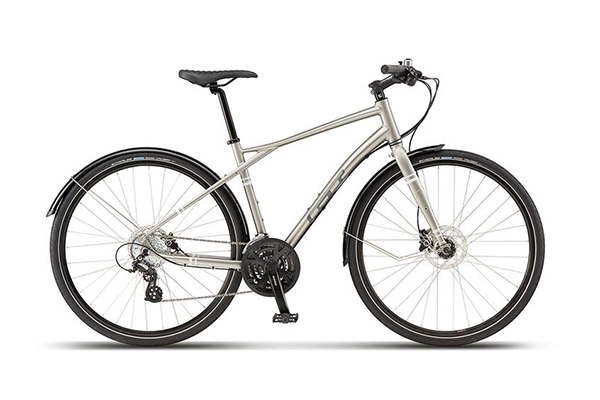Losing weight is a common goal for many individuals, and finding enjoyable and effective ways to exercise is key to achieving that goal. One such activity that combines adventure, fitness, and weight loss is mountain biking. In this blog post, we will explore how mountain biking can be an excellent choice for those looking to shed pounds and improve their overall health and fitness levels.
I. How mountain biking aids in weight loss
Calorie burning potential of mountain biking:
Mountain biking is a highly effective calorie-burning activity, making it an ideal choice for weight loss. In fact, an hour of moderate to intense mountain biking can burn anywhere from 500 to 1000 calories, depending on factors such as body weight, intensity, and terrain.
a. Comparison of calorie expenditure with other activities:
When compared to other common exercises such as jogging or cycling on flat surfaces, mountain biking surpasses them in terms of calorie burn. The varied terrain, obstacles, and constant adjustments required during mountain biking engage multiple muscle groups, resulting in a higher energy expenditure.
Full-body workout:
Mountain biking provides a comprehensive full-body workout, targeting various muscle groups and boosting cardiovascular fitness.
a. Engaging multiple muscle groups:
As you navigate through rough terrains and conquer challenging trails, your legs, core, arms, and back all come into play. The constant pedaling, balancing, and maneuvering engage these muscle groups, leading to improved strength and toning.
b. Increased cardiovascular fitness:
The demanding nature of mountain biking pushes your heart rate up, providing an excellent cardiovascular workout. Regular mountain biking sessions help strengthen your heart and lungs, leading to improved endurance and overall cardiovascular health.
Boosting metabolism:
Mountain biking, especially when incorporating high-intensity interval training (HIIT), can significantly boost your metabolism.
a. Effects of high-intensity interval training (HIIT):
HIIT involves alternating between bursts of intense effort and short recovery periods. By incorporating HIIT techniques into your mountain biking rides, you can maximize calorie burn and stimulate your metabolism. This results in your body continuing to burn calories even after you’ve finished your ride.
b. Long-lasting calorie burn post-ride:
Another advantage of mountain biking is the after-burn effect, known as excess post-exercise oxygen consumption (EPOC). After an intense mountain biking session, your body requires extra oxygen to restore itself to its pre-exercise state, which leads to increased calorie burn even when you’re at rest.
II. Factors influencing weight loss through mountain biking
Duration and intensity of rides:
The duration and intensity of your mountain biking rides play a significant role in weight loss.
a. The importance of gradually increasing intensity:
It’s essential to start at a comfortable intensity level and gradually increase the difficulty of your rides. This progressive approach allows your body to adapt and build strength, while also minimizing the risk of injury.
Terrain selection and difficulty:
The terrain you choose for your mountain biking adventures can impact your weight loss journey.
a. Benefits of off-road trails:
Riding on off-road trails, with their uneven surfaces, inclines, and descents, requires more effort and engages more muscles. This results in a higher calorie burn compared to cycling on smooth, flat surfaces.
Consistency and frequency of rides:
Consistency and frequency are key when it comes to achieving weight loss through mountain biking.
a. Establishing a regular riding routine:
To see results, aim for regular mountain biking sessions. Set realistic goals and create a schedule that works for you, ensuring you have enough time to recover between rides. Consistency will help To see results, aim for regular mountain biking sessions. Set realistic goals and create a schedule that works for you, ensuring you have enough time to recover between rides. Consistency will help your body adapt and maximize the weight loss benefits of mountain biking.
III. Additional benefits of mountain biking for weight loss
Mental well-being and stress reduction:
Engaging in outdoor activities like mountain biking offers more than just physical benefits. The connection with nature and the thrill of conquering challenging trails can provide a significant boost to your mental well-being.
a. Connection with nature and outdoor environments:
Mountain biking takes you away from the hustle and bustle of daily life, immersing you in beautiful natural surroundings. This connection with nature has a positive impact on mental health, reducing stress levels and promoting relaxation.
b. Mental health benefits of physical activity:
Engaging in regular exercise releases endorphins, often referred to as “feel-good” hormones, which can elevate your mood and reduce symptoms of anxiety and depression. Mountain biking provides a dynamic and enjoyable way to reap these mental health benefits.
Building lean muscle mass and toning:
Mountain biking not only helps with weight loss but also contributes to building lean muscle mass and toning your body.
a. Impact on body composition:
As you ride, the combination of pedaling, balancing, and maneuvering works various muscle groups, leading to increased strength and muscle definition. Over time, this can help sculpt a leaner and more toned physique.
Improved overall fitness and endurance:
Regular mountain biking improves your overall fitness level and enhances your endurance.
a. Enhanced stamina and performance:
As you challenge yourself on different terrains and longer rides, your endurance and stamina will naturally improve. This increased fitness level not only benefits your weight loss journey but also enhances your ability to engage in other physical activities.
IV. Tips for effective weight loss through mountain biking
Setting realistic goals:
When using mountain biking as a weight loss tool, it’s important to set realistic and achievable goals that align with your fitness level and lifestyle. Aim to gradually increase the intensity and duration of your rides while keeping your expectations reasonable.
a. Combining weight loss with overall health improvement:
Instead of solely focusing on the number on the scale, prioritize overall health improvements such as increased fitness, strength, and energy levels. This holistic approach will keep you motivated and satisfied with your progress.
Incorporating a balanced diet:
While mountain biking can contribute significantly to weight loss, it’s essential to support your efforts with a balanced and nutritious diet. Opt for whole foods, include plenty of fruits and vegetables, and stay hydrated to fuel your body properly.
a. Importance of proper nutrition for weight loss:
A well-rounded diet provides the necessary nutrients for energy, muscle recovery, and overall well-being. Pairing your mountain biking routine with a healthy eating plan will optimize your weight loss results.
Gradual progression and avoiding burnout:
To prevent burnout or injuries, ensure you progress gradually in terms of intensity and duration. Listen to your body, take rest days, and vary your rides to keep things exciting and challenging.
a. Listening to your body’s limits:
It’s essential to pay attention to any signs of fatigue, pain, or discomfort during your rides. Pushing too hard without giving your body adequate rest can hinder your progress and increase the risk of injuries.
Related:
How Much Weight Can You Lose Biking 30 Minutes a Day?
FAQs:
Q1: Can beginners engage in mountain biking for weight loss?
A: Absolutely! Mountain biking can be enjoyed by riders of all skill levels. If you’re a beginner, start with easy trails and gradually progress to more challenging ones as your skills and fitness improve. Remember to start at a comfortable intensity and gradually increase the duration and intensity of your rides.
Q2: How many times a week should I go mountain biking to see weight loss results?
A: The frequency of your mountain biking sessions depends on your schedule, fitness level, and goals. To see significant weight loss results, aim for at least 2-3 sessions per week. However, it’s essential to listen to your body and allow enough time for recovery between rides.
Q3: Can mountain biking help target specific areas for weight loss, such as the abdomen or thighs?
A: While mountain biking engages various muscle groups and contributes to overall weight loss, it’s important to note that spot reduction is not possible through exercise alone. Weight loss occurs throughout the body as a whole, and focusing on overall fitness and weight loss goals will yield the best results.
Q4: How can I track the calories burned during a mountain biking session?
A: There are several methods to estimate calorie burn during mountain biking. Fitness trackers or smartwatches equipped with heart rate monitors can provide reasonably accurate estimates. Online calculators and mobile apps specifically designed for tracking exercise can also give you an idea of the calories burned based on your weight, duration, and intensity of the ride.
Q5: Is mountain biking suitable for individuals with joint issues or knee problems?
A: Mountain biking is generally considered a low-impact activity compared to running or high-impact sports. However, if you have specific joint issues or knee problems, it’s important to consult with a healthcare professional or a sports medicine specialist before starting any exercise program. They can provide guidance on modifications or exercises to help protect your joints while still enjoying the benefits of mountain biking.
Q6: Can I lose weight through mountain biking if I have limited access to trails?
A: Absolutely! While off-road trails offer unique challenges and benefits, you can still achieve weight loss through mountain biking on paved paths, roads, or even indoor stationary bikes. The key is to maintain an appropriate intensity and duration during your rides, regardless of the terrain.
Conclusion:
Mountain biking offers a thrilling and effective way to lose weight and improve overall fitness. With its high-calorie burn, full-body workout, and metabolism boosting benefits, mountain biking is a fantastic choice for weight loss. By engaging multiple muscle groups, challenging your cardiovascular system, and boosting metabolism, it can help you shed pounds and achieve your fitness goals.
Remember to consider factors such as the duration and intensity of your rides, the terrain you choose, and the consistency of your biking routine. Gradually increasing intensity, opting for off-road trails, and maintaining a regular schedule will optimize your weight loss journey.




